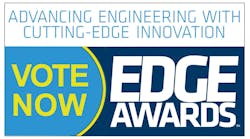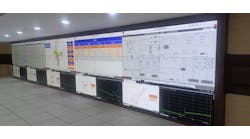Schleiss Predicts that Emerson's Forthcoming DeltaV Launch Will Be "at Least as Big as DeltaV SIS"
Observers and competitors who have speculated that DeltaV is "getting a bit long in the tooth," as one contributor to Jim Pinto's Emerson weblog put it back in May 2008, may have their expectations―or is that their apprehensions?―confirmed at the forthcoming Emerson Global Users Exchange at the end of September. Normally such suggestions are met with robust denials and assertions that, as a continually evolving system based on COTS technologies, DeltaV has more than kept abreast with competitors' developments and that, in its current incarnation, it bears little resemblance to the original system which first saw the light of day back in 1996.
Time to Sit Up and Take Notice
So when Duncan Schleiss, vice president of marketing at Emerson Process Management, says that this year's Emerson Exchange in Orlando at the end of September will see initiatives related to DeltaV which are "at least as big as DeltaV SIS" it's time to sit up and pay attention.
Schleiss was talking to INSIDER over dinner in London on his way from the Netherlands to the Ovation user conference in Pittsburgh in late July and, while he gave absolutely nothing away in terms of the actual content of the forthcoming announcement, he made it pretty clear that this was the 'DeltaX' referred to by, among others, Control's Walt Boyes and Keith Larson after last year's Exchange or, indeed, the 'DeltaVx' suggested, tongue in cheek, by ABB's Nick Laming earlier this year, a suggestion Schleiss said they had been tempted to adopt.
Both the original DeltaV in 1996 and DeltaV SIS in 2004 marked radical departures from then current accepted thinking so it's fair to assume that if Schleiss, who was arguably the major driver behind both initiatives, puts the forthcoming announcement in that category, visitors to this year's exchange can expect something rather more significant than the normal round of annual updates and enhancements. And while he gave little or nothing away last month, there are pointers to where that radical thinking might be directed. Presentations at, and journalist briefings during and after last year's Exchange in Washington both highlighted the new features in the then-latest release, DeltaV version 10.3, and gave pointers to what might follow. The former included support for Windows Vista and a range of new configuration and engineering tools, but the latter focussed particularly on detailed, but wide-ranging, research Emerson had been conducting into who its users are, what they do and what they expect of their systems.
Homer, Gunther and Ian
As a result Schleiss's team was able to build up 20 or more generic users or "characters," dubbed, among others, "Homer, " "Gunther" and "Ian, " with roles ranging from operator to instrument technician, and to define around them the characteristics that a new generation process automation system would need to have in order to satisfy their needs and aspirations.
From there it's perhaps a short step to speculate that the major emphasis in September will be on greater ease of use for both operators and maintenance and support staff. "We are big proponents [of[ making it easy for the instrument technicians," Schleiss had told Boyes and Larson last year.
Another pointer could be Schleiss's interest in and acknowledged admiration for the Honeywell-led Abnormal Situations Management (ASM) consortium, if only as a marketing exercise. He told INSIDER that Emerson had at one point expressed an interest in joining the consortium, but had been less enthusiastic when it had been explained that it would have had subsequently to pay to use any of its own intellectual property which it might have made available, a realization which gave rise to a particularly wry "Schleissism. "
Media Teasing
All in all, this latest conversation with INSIDER, no doubt to be repeated with others on an increasingly frequent basis between now and the end of September, was as neat a piece of media teasing as you're likely to encounter. Our interest has been aroused and communicated to our readers, thereby getting potential users and competitors on the edge of their seats, while Schleiss has given absolutely nothing away. Nice one, Duncan.
Among the other topics touched on in a wide ranging conversation over the scallops and fish pie was the ongoing relationship between FDT, EDDL, FDI and now FDT 2.0.
Readers may recall that outgoing FDT Group managing director Flavio Tolfo had seemed to raise doubts in conversation with INSIDER that the ambition of the FDI initiative to effect an eventual convergence of the rival technologies was in fact achievable, thus leading us to conclude that "The decision to go ahead with FDT 2.0 represents a tacit admission, at least from the FDT side, that he two technologies are ultimately mutually incompatible."
Schleiss, however, seems to take the opposite view, not only suggesting that FDI's objectives are realizable, but also raising doubts about FDT 2.0. The latter, he suggests, presents device manufacturers, including presumably Emerson itself, with the challenge and the cost of having to revise all of their existing DTMs in order to comply with FDT 2.0 once it becomes available.
It may or may not be a coincidence that the announcement made by the EDDL Cooperation Team (ECT) earlier this year that the FDI Project Team "has achieved important milestones" seems to have been re-released and has recently appeared in a number of publications including ARC's weekly ARCwire update. For those, including us, who missed it first time round, the announcement said that validation of the detailed specification would begin in the second quarter of this year, while details of the exact FDI architecture and associated device interface are set to be unveiled with the release of the final functional specification in the summer of 2010. That architecture is described as a client/server structure based on OPC UA with a "device package" provided by the device supplier containing EDDL components and an optional programmed component for programmed user interfaces.
Emerson's DeltaV is enabling increased accuracy and speed of recipe changes at Pernod Ricard Nordic's new bitters blending facility at Aalborg, Denmark. As the main automation contractor, Emerson was responsible for front-end engineering and design (FEED) and implementation of the PlantWeb-based solution which also incorporates HART communications and intelligent devices. The ISA88-compliant solution controls blending from some 130 tanks in the facility.



